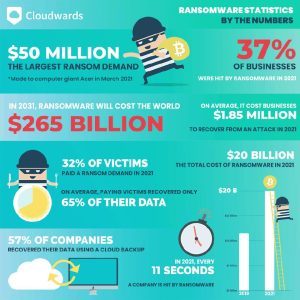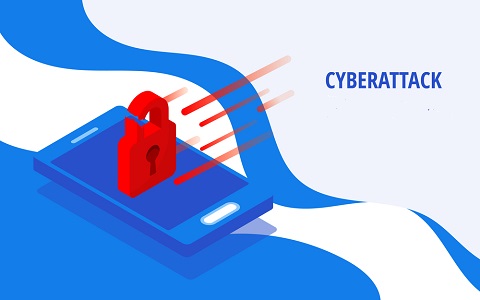
The year 2021 was very difficult for cybersecurity in many areas. Solar Winds, Colonial Pipeline, and many other breaches that had a significant economic and security-related impact were some of the most prominent. Ransomware attacked many small and medium-sized businesses with a furious vengeance. Worst of all was the fact that adversaries exploited security vulnerabilities in supply chains and critical infrastructure at higher rates than ever before. We are only beginning to see some of the trends that will be prevalent in 2022, even though it is only January.
Cybersecurity and business
In the past two years, there has been a shift in work from traditional offices to remote or hybrid locations. Statistics show that hackers welcomed this shift and took advantage the security gaps and vulnerabilities in businesses.
Based on the Allianz Risk Barometer, cyber perils will be the greatest concern for companies worldwide in 2022. Data breaches, ransomware attacks, and major IT outages are more of a concern to companies than disruptions in business supply chains or natural disasters, which all have impacted firms heavily over the past year.
A new study by Positive Technologies on pentesting projects, which was conducted among financial institutions, fuel and energy organizations, government bodies, industrial companies, IT companies, and other sectors, has revealed that there are many findings. An external attacker can penetrate an organization’s network perimeter to gain access the local network resources. This is true in 93% of cases.
In 2021, 50% more cyberattacks were made on businesses.
New data shows that cyberattack attempts rose to an all-time high in the fourth quarter of 2021 partly because Log4j. In 2021, the largest number of attacks on cyberattacks was sustained by research and education sectors. Government/military, communications and communications were next. Source: Check Point Software
Cybersecurity for Small and Medium Sized Business
Many large companies were hacked, but small and medium-sized businesses were easier targets because they lack the security expertise and resources.
Trends and statistics on cyber attacks in 2022
 Cyberattacks on businesses of all sizes, but especially small- to medium-sized, are becoming more frequent and targeted. Accenture’s Cost of Cybercrime Study found that 43% of cyberattacks are directed at small businesses. However, only 14% of those targeted are equipped to defend themselves.
Cyberattacks on businesses of all sizes, but especially small- to medium-sized, are becoming more frequent and targeted. Accenture’s Cost of Cybercrime Study found that 43% of cyberattacks are directed at small businesses. However, only 14% of those targeted are equipped to defend themselves.
Cyberattacks can disrupt normal operations and cause significant damage to IT infrastructure and assets that may be difficult to repair without sufficient resources or budget.
This is a problem for small businesses that makes it difficult to protect themselves. Ponemon Institute’s State of Cybersecurity Report reports that cyberattacks have been reported by small and medium-sized businesses around the world.
- Insufficient security measures: 45% of respondents say their systems are not effective in mitigating attacks.
- Sixty-six percent of victims have been the victim of a cyberattack in the last 12 months.
- Background of attacks: 69% believe that cyber attacks have become more targeted.
These are the most common attacks on small businesses:
- Phishing/Social Engineering: 57%
- Compromised/Stolen Devices: 33%
- Credential theft: 30%
For understanding cyber threats and vulnerabilities, as well as the implications of successful attacks on cyber security, it is important to keep up-to-date with current cyber-attack statistics.
- 43% of data breaches are small- and medium-sized businesses.
- 61% of SMBs reported at least one cyberattack in the past year, so if you are still unsure about your small business being a victim, think again.
- A CISCO benchmark study found that 40% of small businesses were affected by a serious cyber attack and had to go offline for at least eight hours. This downtime is a significant cost in a security breach.
- Ransomware was not one of the top cyber threats small businesses identified in the study. Ransomware is a concern for a large percentage of Managed Service Providers (MSP).
- 30% of small businesses consider Phishing attacks the greatest cyber threat.
- 83% of small- and medium-sized companies aren’t financially ready to recover from cyber attacks.
Despite these staggering statistics, 91% of small business owners have not purchased cyber liability insurance or consulted with an IT Support company such as Adtek Advanced Technologies. This demonstrates how unprepared small businesses are to deal security breaches.
Ransomware:

Ransomware by the Numbers CLOUDWARDS
Ransomware is a cyber-weapon that hackers prefer to use. Although it has been around for decades now, ransomware was first introduced in 2021. Ransomware is a popular way to steal data and hostage it for payment in cryptocurrencies.
Five Key Ransomware Statistics
- In 2021, ransomware was estimated to have cost the world $20 Billion. This number is expected rise to $265 Billion by 2031.
- Ransomware affected 37 percent of all organizations and businesses in 2021.
- In 2021, businesses spent $1.85 million to recover from ransomware attacks.
- 32 percent of ransomware victims pay ransom but only 65 percent get their data back.
- Only 57% of businesses have been able to recover their data from a backup.
Ransomware is rampant, which is a sobering fact. Ransomware will be a constant threat due to the availability of soft targets. Our lives are impacted by an ever-increasingly connected world. Every industry and every organization will need to manage and protect data from now on.
Understanding and being aware of ransomware can help to address many cybersecurity problems. The emergence of cybersecurity tools, protocols, and mitigation tools can help to limit the growing trend in ransomware attacks. It is time to take proactive measures to secure networks, devices and systems and to make them more resilient.
Cyber Statistics You Need to Know For 2022
 Phishing Attacks. Phishing attacks were linked to 36% breaches, an increase in 11% which could partly be attributed to COVID-19 pandemic. As you might expect, threat actors are known to modify their phishing campaigns according to what is happening in the news. (Verizon 2021 Data Breach Investigations report)
Phishing Attacks. Phishing attacks were linked to 36% breaches, an increase in 11% which could partly be attributed to COVID-19 pandemic. As you might expect, threat actors are known to modify their phishing campaigns according to what is happening in the news. (Verizon 2021 Data Breach Investigations report)
Data Breach Cost: The 2021 data breach cost was the highest in 17 years. It rose from US$3.86 to US$4.24 millions annually. (IBM Cost of a Data Breach Report 2021
Ransomware Payments: Cryptocurrency is the preferred payment method of cybercriminals, particularly when it comes to ransomware. Ransomware payouts for the 10 most popular ransomware variants could be responsible for as much as US$5.2 Billion in outgoing Bitcoin transactions. (FinCEN report on Ransomware Trends In Bank Secrecy Act Data).
DDoS attacks: Due to the COVID-19 pandemic, the number of distributed denials-of-service (DDoS), attacks has been increasing. 2020 saw over 10 million attacks, which is 1.6 million more than in the previous year. (ENISA Threat Landscape 2021).
If this article has got you thinking – good. Small business are at risk but there is a solution. Call Adtek Advanced Technologies today for a complete review of network and suggestions on how you can be secure in 2022. Don’t put this off until after an attack! Be proactive – call now.
Adtek Advanced Technologies
Rock Hill, SC 29730
(803) 902-3111
Dillon, SC 29536
843-627-3079


 Poor visibility can put organizations at risk of cyberattacks
Poor visibility can put organizations at risk of cyberattacks
 Cyberattacks can devastate your company. Cybercriminals and hackers can outsmart
Cyberattacks can devastate your company. Cybercriminals and hackers can outsmart  A
A  A 2020 IBM report found that it takes on average 228 days to detect a breach. It is impossible to imagine the amount of damage that could be done in just 228 days. Add on recovery time and it could take up to a year before you can get back to normal.
A 2020 IBM report found that it takes on average 228 days to detect a breach. It is impossible to imagine the amount of damage that could be done in just 228 days. Add on recovery time and it could take up to a year before you can get back to normal. These cyber threats will constantly be a threat to your computer systems. You can avoid them by raising awareness within your company and using the security tools available to you.
These cyber threats will constantly be a threat to your computer systems. You can avoid them by raising awareness within your company and using the security tools available to you.